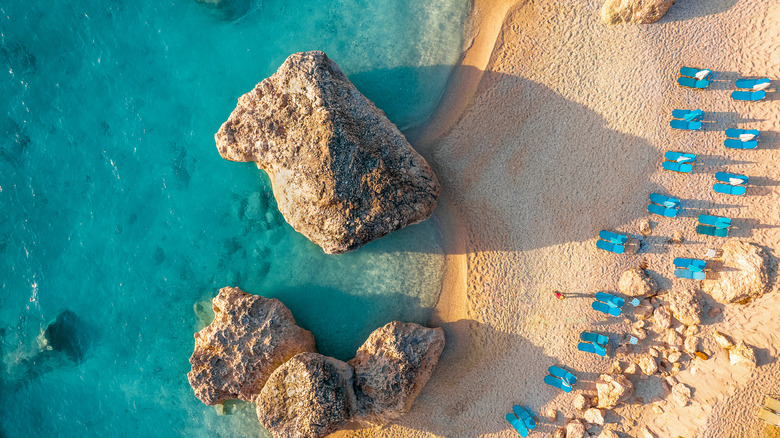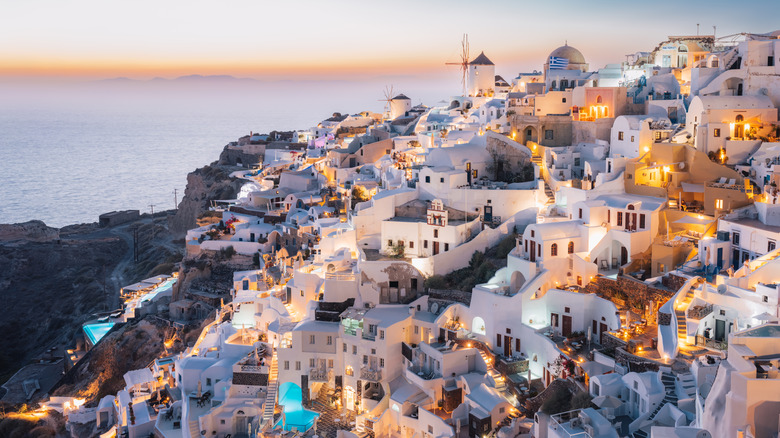One Of Greece's Most Iconic Tourist Islands Is Under Watch Amid Earthquake Swarm
Among the Greek islands, Santorini boasts some of the most stunning scenery. It's known for its whitewashed villages spilling down the cliffsides as well as its spectacular panoramic vistas, where you can watch the sunset over the turquoise Aegean Sea. Lately, however, island life has not been all sunsets and souvlaki. Since the end of January, thousands of small earthquakes have rattled nerves and windowsills on Santorini as well as on the neighboring islands of Ios and Amorgos.
So far, the magnitude of the quakes has ranged from 3 (slight) to just over 5 (moderate), in other words, not large enough to cause any significant damage. However, the tremors have been increasing in frequency and magnitude, suggesting a "foreshock" pattern in which a much stronger quake is brewing and could strike in the near future. This is worrisome given Santorini's history: The island's last major quake struck with a magnitude of around 7.5 in 1956, destroying hundreds of houses, killing 53 people, and precipitating an 80-foot high tsunami. The increasing seismic activity could also indicate an impending volcanic eruption, another frightening possibility considering that an eruption on Santorini in 1600 B.C. buried whole settlements, leading to the near-collapse of the regional Minoan civilization. This was, in fact, the most powerful volcanic eruption ever observed by humans.
Both prospects — that of a larger earthquake and/or a volcanic eruption — have residents on "tenterhooks," Santorini resident Veroniki Balabonidi told the Guardian: "Everyone I know has been sleeping outside, in their cars, with one member of the family staying awake all night to keep watch ... I'm 38 and have never experienced anything like it." Like thousands of other residents, Balbonidi chose to evacuate the island and is now staying with family in another part of Greece.
What to know if you're planning a trip to Santorini
According to Greece's Earthquake Planning and Protection Organization, the seismic crisis could go on indefinitely, for days, weeks, or even months. Given the ongoing uncertainty and the fact that many residents and tourism industry employees have left the island, now is certainly not the best time to visit Santorini. If you haven't made any reservations yet, consider an alternative Greek island destination such as Folegrandros, which has scenery similar to Santorini but is cheaper and without the crowds. If you already have reservations but prefer to cancel, you may be able to obtain full or partial refunds given the fact that a state of emergency has been declared on Santorini. The best thing to do is to contact your airline, hotel, tour operators, and travel insurance agent (if you purchased insurance), as soon as possible to discuss all your options. If you paid for your trip with a credit card that offers travel insurance
If you have a high risk tolerance and plan to visit Santorini anyway, expect some disruptions due to travel businesses grappling with understaffing and implementing additional safety measures. For example, hotels on the island have been instructed to drain swimming pools to protect against property damage in the event of a large quake. The Greek ministry is encouraging people not to attend large indoor gatherings and choose safe routes when moving around the island, avoiding landslide-prone areas as well as the ports of Amoudi, Armeni, Korfos, and Old Port (Paleos Limenas) in the area of Fira. In the event of a strong quake, the ministry is advising that people immediately vacate coastal areas and follow the guidance of local authorities. Lastly, before departing to this or any other at-risk destination, check out our article on other important things you can do if you experience a natural disaster while traveling.

